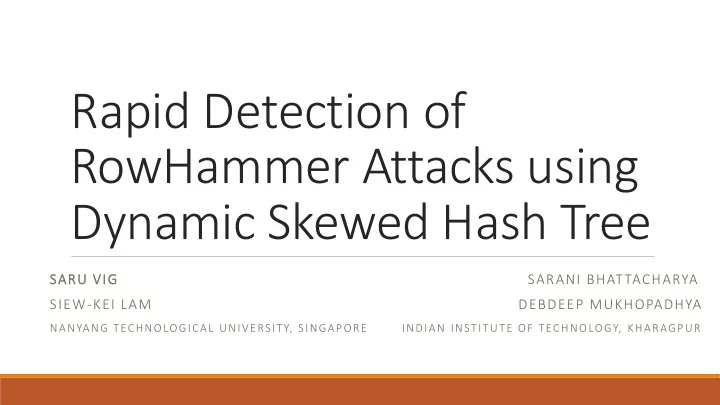

Rapid Detection of RowHammer Attacks using Dynamic Skewed Hash Tree SARU VIG SARANI BHATTACHARYA SIEW-KEI LAM DEBDEEP MUKHOPADHYA NANYANG TECHNOLOGICAL UNIVERSITY, SINGAPORE INDIAN INSTITUTE OF TECHNOLOGY, KHARAGPUR
Overview Introduction Motivation Proposed Work Results Conclusion Q&A
Introduction What is the RowHammer Attack ? ◦ DRAM is hierarchically composed of Channels, Rank and Banks. ◦ Each bank is a collection of cells having typically 2 14 to 2 17 rows ◦ Attackers can repeatedly open (i.e. activate) & close (i.e. precharge) DRAM rows in the same memory bank to induce bit flips in the adjacent rows.
Introduction What is the RowHammer Attack ? ◦ In particular, the repeated charging and discharging of row cells in a short span of time causes electronic disturbance which could result in bit-flips in the DRAM cells of the adjoining rows. ◦ The row which is being repeatedly accessed is denoted as the aggressor row. ◦ The two adjoining vulnerable rows, where the flips occur are called the vulnerable rows.
Motivation Existing Strategies ◦ Hardware resources to maintain the state of DRAM rows ◦ Selective refreshing ◦ High power and performance overhead ◦ Increased Latency of memory operations
Memory Integrity Trees Most memory protection schemes consists of some form of encryption and an Integrity Tree What are Integrity Trees ? ◦ Equal sized blocks which form the leaf nodes ◦ Recursively apply an authentication function to generate tree ◦ Root hash has to match with the value stored on chip ◦ Verification is performed on each level while accessing the data stored in leaf nodes What is a Dynamic Integrity Tree ? ◦ Tree that can re-structure itself during run-time (add and delete nodes). General form of a 2-ary binary tree
Proposed Work Main Contribution ◦ A sliding window mechanism is introduced to identify vulnerable rows ◦ Dynamic integrity tree structure is proposed to enable newly detected vulnerable rows to be dynamically inserted into the tree, while rows that are no longer a concern are removed Mechanism ◦ RowHammering on processors with DDR3 DRAM was performed. Memory access logs were studied to show that the combination of the sliding window mechanism and dynamic tree structure effectively detects bit flips. Also, it constrains the height of the tree, which enables low- overhead and rapid detection of bit-flips
Framework
Framework When is a row vulnerable ? ◦ At least X DRAM accesses made to the neighbouring rows from the same bank within window frame of size p ◦ p stands for the number of DRAM accesses that the window is going to be monitoring at any given time Window Frame Size ◦ Depends on time taken for one DRAM access after performing clflush instruction ◦ For hammering to be successful, a minimum number of DRAM accesses of the same bank must be made within a small activation interval before (~ 500ns) the DRAM refreshes (~64 ms)
Tree Representation • A SUB_TREE consists of two leaf nodes and their parent. At any one time, we add/remove a single subtree rather than a single node (i.e. two adjoining neighbours of the aggressor rows, which form the leaf nodes of the SUB_TREE) • Tree node structure has additional fields of parent and sibling node number.
Tree Representation ReadNCheck ◦ A recursive procedure to re-calculate the hash at all the levels of the tree and match them with the one already stored in the tree ◦ The verification will be performed at two instances: ◦ If any node of the tree is accessed ◦ Whenever a node is removed Hash Function ◦ We use SHA3-256 (Keccak[512] (M || 01, 256)) as the hash algorithm. The output of this function is 256 bits for any given input
Implementation Example X =2 and p =10
Results • Examined three different memory logs to identify the patterns exhibiting bank locality • Varying X and p • High number of vulnerable and selectively refreshing them without confirming presence of an error will cause a high overhead
Results • The experiments revealed that at any given time, the average number of aggressor rows in a single frame is 4 at any given time, with the maximum being 8 • Limits the height of the tree from 3-4 levels
Memory and Time Overhead For a tree with n leaf nodes the overhead is calculated to be in bits as ◦ M DT = (256 + 2 ∗ log 2 n) ∗ (2 ∗ n − 1 ) ◦ n varies from 4 to 8 Total time taken to create a SUB_TREE in all the four cases is ≤ 2ms Adding/Removing nodes from the tree have a overhead between 2-6 ms depending on which level of tree the update occurs Additional latency of accessing the memory rows after tree traversal and verification caused by ReadNCheck function pertains only to the victim rows that are accessed while they are a part of the tree. The aggressor rows and other row access are still being read with the same frequency as under normal conditions.
Conclusion Proposed a framework for rapid detection of multiple bit flips due to RowHammer using dynamic integrity tree, where nodes can be added/removed based on a vulnerability criterion A sliding window that effectively limits the height of the tree for maintaining vulnerable rows The criterion and size of the sliding window can be fixed to attain maximum security Experimental results confirm that the proposed framework will enable rapid detection of bit flips due to RowHammer attack Future Work: ◦ More experimental results: Miss Rate, Power, Area etc. ◦ More quantitative comparison with other existing techniques
Thanks & Questions
Recommend
More recommend